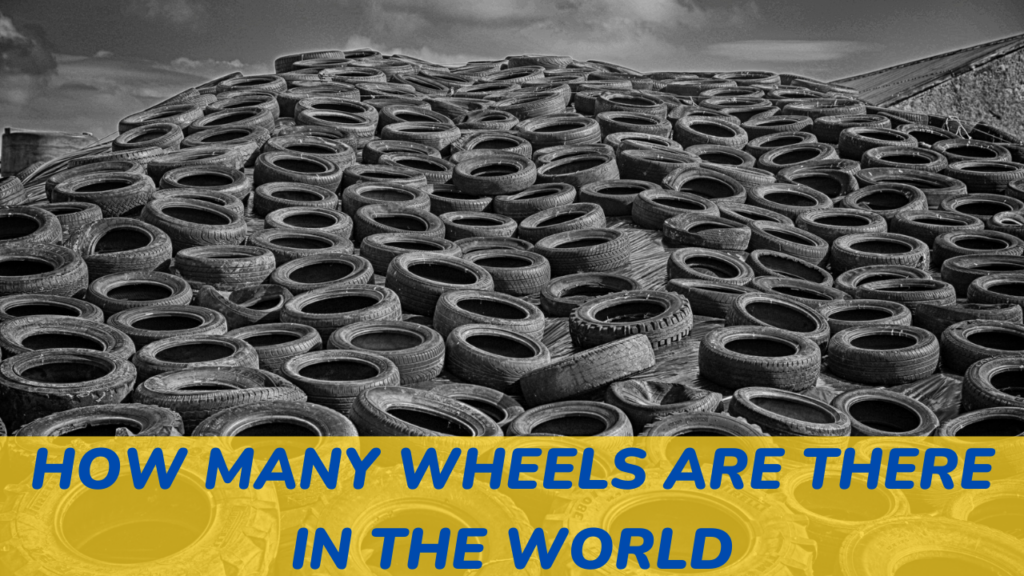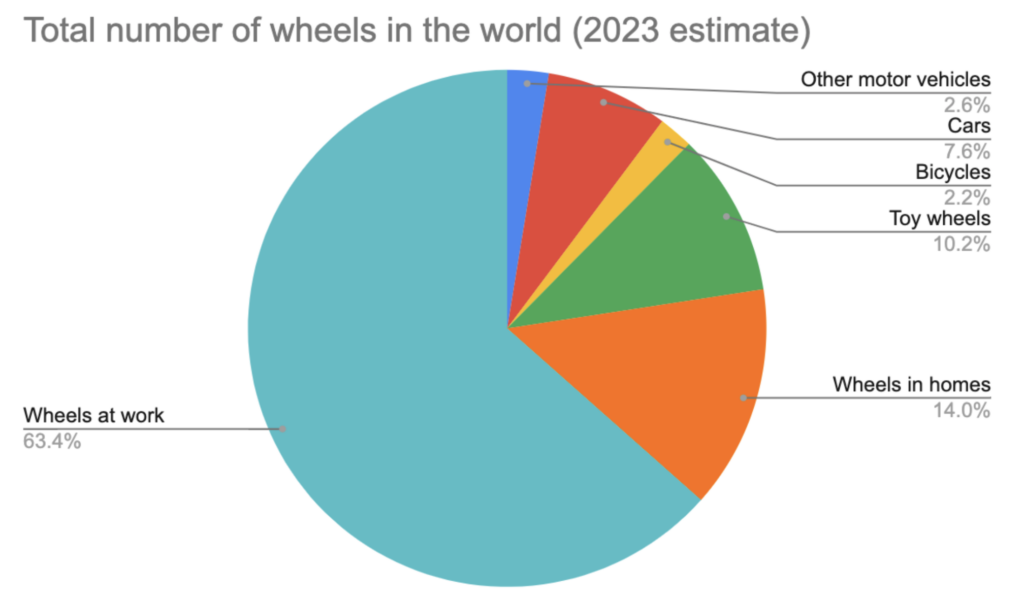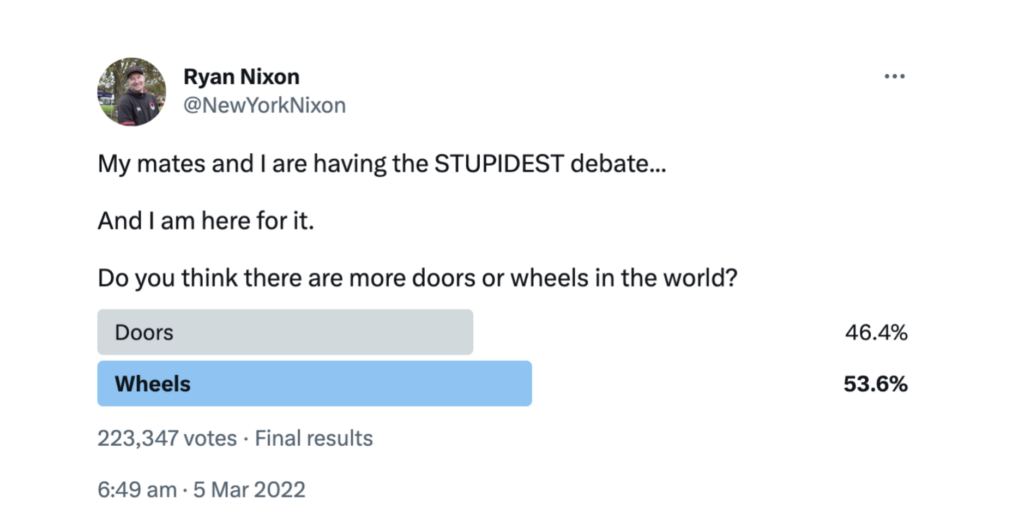
Have you ever stopped to consider how many wheels there are in the world? As brain teasers go, it’s a pretty good one. Think about it for a minute and take your best guess: 2 billion? 20 billion? 200 billion?
You are probably thinking about wheels on cars, but what about other modes of transportation? And wheels you find on objects in the home and at work e.g. on vacuum cleaners and baby walkers?
Unsurprisingly, the exact number is impossible to know for such a complex question. However, we have taken a fresh look at the latest research and data to come up with an estimate for the total number of wheels in the world.
There are approximately 93 billion wheels in the world, with passenger tires accounting for 7.6% (7 billion), other motor vehicles accounting for 2.6% (2.4 billion) and toy wheels accounting for 10.2% (9.4 billion).

To calculate this total, we had to establish all the possible uses, places, and objects that require wheels; the average number of wheels per object; and the annual manufacturing output of the key contributing products. We uncovered some very eye-opening facts, so read on to discover more.
EVERYTHING THAT HAS WHEELS
When we think of wheels, we typically think of cars, bicycles, and trucks. You simply need to look around you to know that not all wheels are attached to vehicles and sometimes, they pop up in the most unexpected places.
The below list summarizes the main uses of wheels and the average number per object:
| VEHICLES | AVG. NO. OF WHEELS* |
|---|---|
| Car | 6 |
| Train | 1060 |
| Bus | 5 |
| Coach | 5 |
| Tram | 40 |
| Truck | 7 |
| Semi truck | 19 |
| Scooter | 2 |
| Motorcycle | 2 |
| All-terrain vehicle | 4 |
| Ambulance | 5 |
| Fire truck | 7 |
| Camper | 5 |
| Wagon | 4 |
| Cart | 4 |
| Trailer | 4 |
| Airplane | 6 |
| Military vehicle | 7 |
| Garbage truck | 7 |
| Tractor | 5 |
| Combine harvester | 5 |
| Digger | 5 |
| Bicycle | 2 |
| Unicycle | 1 |
| Tricycle | 3 |
| DOMESTIC & COMMERCIAL | AVG. NO. OF WHEELS |
| Lawnmower | 4 |
| Garbage can | 2 |
| Laundry cart | 4 |
| Bar cart | 4 |
| Drawer | 4 |
| Office chair | 5 |
| Vacuum cleaner | 2 |
| Computer mouse | 1 |
| Shopping cart | 4 |
| Hand truck | 2 |
| Luggage trolley | 4 |
| Baby stroller | 4 |
| Wheelbarrow | 2 |
| Hamster wheel | 1 |
| Dishwasher rack | 4 |
| Mop bucket | 4 |
| LEISURE | AVG. NO. OF WHEELS |
| Ferris wheel | 1 |
| Roulette wheel | 1 |
| Roller skates | 4 |
| Roller blades | 4 |
| Skateboard | 4 |
| Exercise bike | 1 |
| Golf cart | 5 |
| Golf trolley | 3 |
| Suitcase | 4 |
| Toy vehicles | 3 |
| Toy baby strollers | 4 |
| MOBILITY & MEDICAL | AVG. NO. OF WHEELS |
| Baby walker | 4 |
| Wheelchair | 4 |
| Wheeled walker | 4 |
| Mobility vehicle | 4 |
| Hospital bed | 4 |
| Stretcher | 4 |
*Note that the above averages include steering wheels in the appropriate vehicles as well as spare tires in automobiles.
With this information in hand, we can now extrapolate the approximate total number of wheels using existing market and population data. Firstly, let’s consider vehicles.
HOW MANY VEHICLES ARE THERE IN THE WORLD?
In our previous blog post, How Many Cars Are There In The World?, we learned that there are roughly 1.546 billion vehicles (passenger cars, motorcycles, buses, commercial vehicles) worldwide, out of which 1.19 billion are passenger cars. Using the above averages, this equates to about 7.10 billion wheels, of which 5.95 billion belong to cars.
This accounts for the majority of motor vehicles in the world however we must also consider the prevalence of bicycles. Worldometer shows that from 1970 onwards, bicycle production began to outpace car production, and by 2003, more than twice as many bicycles were being produced than cars (100 million units per year versus 42 million cars). It is now estimated that there are more than 1 billion bicycles in the world today, with over half of them found in China. This adds another 2 billion wheels to the running total.
A WORLD RECORD AMOUNT OF TOY WHEELS
As strange as it seems, the current Guinness World Record holder for the largest annual volume tire manufacturer is Lego. In 2010 they produced 381 million tires, far above any of the life-size tire brands. Hot Wheels is another wildly popular toy vehicle brand that has consistently ranked among the best-selling toys for over 6 decades. In fact, one Hot Wheels toy is sold every 16 seconds and over 6 billion have been sold in total since its inception.
If we assume that only the Lego and Hot Wheels toys that were produced and sold in the last 5 years remain in existence, this works out to 9.5 billion wheels – the same quantity as full-size wheels. This is not surprising as toy vehicles are cheap and frequently bought in multiples whereas their more expensive, life-size counterparts are only owned by 18% of the global population. The true number of toy wheels is likely to be a lot higher, given that both toy brands are long-lasting and timeless.
ARE THERE MORE WHEELS THAN DOORS IN THE WORLD?
The number of wheels in the world came into focus as part of a wider debate that exploded onto the internet last year. Ryan Nixon turned to his modest Twitter following to ask if there are more doors or wheels in the world.

The tweet went viral and prompted widespread discussion that involved everyone, from confused social media users to top mathematicians and scientists. What seemed like a simple question quickly became a feat of intellectual gymnastics and proved highly divisive. Those in favor of doors (#TeamDoors) emphasized the abundance of buildings with internal doors, cupboards, and lockers. On the other hand, wheel advocates (#TeamWheels) were quick to point out that cars not only have 4 wheels, but also a steering wheel and a spare wheel.
As the above poll shows, wheels triumphed over doors by a comfortable margin. This came down to a few key arguments:
- The definition of a wheel versus the definition of a door. Even by the strictest interpretation of what both of these objects are, it was generally agreed that wheels are far more versatile than doors and are therefore used more widely e.g. gears, cogs, and flywheels are all types of wheels used in machinery.
- In objects that have both wheels and doors (automobiles, toy cars, houses, etc.), the number of wheels usually exceeds the number of doors. Taking toy cars as an example, they will all have at least 4 wheels, but often do not have any functioning doors.
- There are more objects with multiple wheels and no doors (baby strollers, bicycles, rollerblades, etc.) than there are objects with doors but no wheels (advent calendars, a newly-constructed, empty house, etc.).
Combining these points with our research, we declare ourselves firmly on the side of #TeamWheels.
HOW MANY WHEELS ARE THERE AT HOME AND WORK?
Existing estimates of the number of wheels tend to overlook those that are found in the home and at work. There is little to no data on the average number of wheels per household but we can make a few reasonable assumptions. Firstly, we know that there are approximately 2.3 billion houses in the world. There are huge disparities in living standards globally so we can assume that the majority of wheels in homes are concentrated in more economically developed countries. If we take the United States as an example, which has 133 million households:
- With an average of 10 wheels per household, there would be 1.3 billion wheels
- With an average of 100 wheels per household, there would be 13 billion wheels
Similarly, if we look at the 5.9 million commercial buildings that are in the United States, using higher averages to account for the increased number of drawers, chairs, commercial cleaning trolleys, computer mice, moveable furniture, etc.:
- With an average of 1,000 wheels per building, there would be 5.9 billion wheels
- With an average of 10,000 wheels per building there would be 59 billion wheels
It is evident that the number of wheels not found on vehicles is too significant to be ignored. For our estimate, we have included the, higher rates for the US as a minimum.
Conclusion
It is astonishing that modern society is still so reliant on a simple invention from 3500 BC. Moreover, as living standards across the world continue to improve, the number of wheels will grow exponentially. Our total estimate is conservative because it does not take into account every single mode of transportation but only those that exist in the most significant numbers. Additionally, the estimate does not include internal wheels in machinery, such as flywheels in engines or the wheels within conveyor belt mechanisms, lifts, and escalators.
The total number would be markedly higher if all of these wheels are included. While we cannot be certain of the precise number of wheels in existence, we can confidently state that wheels really do make the world go round.
